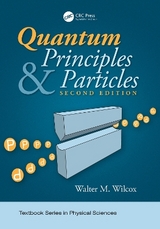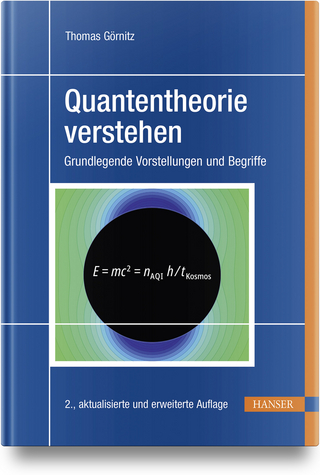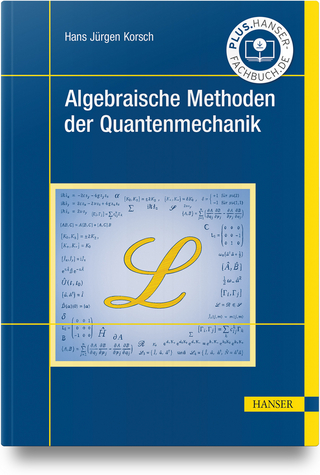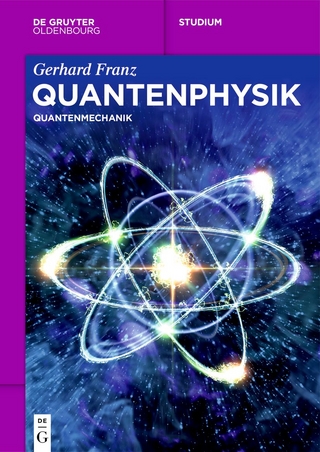
Quantum Principles and Particles
Crc Press Inc (Verlag)
978-1-4398-3525-8 (ISBN)
- Titel erscheint in neuer Auflage
- Artikel merken
"A physical understanding is a completely unmathematical, imprecise, and inexact thing, but absolutely necessary for a physicist."
—R. Feynman
The core of modern physics, quantum theory is counter-intuitive and challenging for those new to the field. Quantum Principles and Particles presents the fundamental quantum principles in a particularly visual manner and applies them to aspects of particle interactions. Inspired by the author’s work with Nobel laureate Julian Schwinger, it introduces the primary principles of the microscopic world through an analysis of the simplest possible quantum mechanical system—spin 1/2.
A Visual Approach to Quantum Mechanics
This two-semester introductory undergraduate textbook balances simplification and rigor to provide an accessible, solid foundation in quantum mechanics. Taking a unique pedagogical approach, the author uses hypothetical quantum devices—process diagrams—to orient and guide the reader. These process diagrams help readers visualize states and operators, and illustrate ways to compute amplitudes for quantum mechanical processes.
From Small Steps in Quantum Mechanics to a Leap into Particle Physics
The first part of the book presents the essential principles in the development of quantum mechanics, starting with spin state analysis and wave mechanics. Delving into quantum particles, the second part develops a consistent picture of particle descriptions and interactions in atomic, nuclear, and particle contexts. The text emphasizes applications and makes the connection to the Standard Model of particle physics. In each chapter, carefully designed problem sets reinforce key principles and stimulate original thought. Extensively illustrated, this classroom-tested text provides a clear and comprehensive introduction to quantum mechanics.
Walter Wilcox is professor of physics and graduate program director for the Baylor University Physics Department. He earned a PhD in elementary particle physics from UCLA in 1981 under the guidance of Dr. Julian Schwinger. He has also taught and done research at Oklahoma State University (1981–1983), TRIUMF Laboratory (1983-1985), and the University of Kentucky (1985–1986). He has been awarded grants from the National Science Foundation (NSF) in theoretical physics and, in collaboration with Ron Morgan, in applied mathematics. His research focuses on the development and use of numerical methods in the field of theoretical physics known as "lattice QCD". He lives in Waco, Texas, and loves to go hiking and camping. For more information about Dr. Wilcox’s work, see Dr. Wilcox’s web site at Baylor University.
QUANTUM PRINCIPLES
Perspective and Principles
Prelude to Quantum Mechanics
Stern–Gerlach Experiment
Idealized Stern–Gerlach Results
Classical Model Attempts
Wave Functions for Two Physical-Outcome Case
Process Diagrams, Operators, and Completeness
Further Properties of Operators/Modulation
Operator Reformulation
Operator Rotation
Bra–Ket Notation/Basis States
Transition Amplitudes
Three-Magnet Setup Example—Coherence
Hermitian Conjugation
Unitary Operators
A Very Special Operator
Matrix Representations
Matrix Wave Function Recovery
Expectation Values
Wrap Up
Problems
Free Particles in One Dimension
Photoelectric Effect
Compton Effect
Uncertainty Relation for Photons
Stability of Ground States
Bohr Model
Fourier Transform and Uncertainty Relations
Schrödinger Equation
Schrödinger Equation Example
Dirac Delta Functions
Wave Functions and Probability
Probability Current
Time Separable Solutions
Completeness for Particle States
Particle Operator Properties
Operator Rules
Time Evolution and Expectation Values
Wrap-Up
Problems
Some One-Dimensional Solutions to the Schrödinger Equation
Introduction
The Infinite Square Well: Differential Solution
The Infinite Square Well: Operator Solution
The Finite Potential Barrier Step Potential
The Harmonic Oscillator
The Attractive Kronig–Penny Model
Bound State and Scattering Solutions
Problems
Hilbert Space and Unitary Transformations
Introduction and Notation
Inner and Outer Operator Products
Operator–Matrix Relationship
Hermitian Operators and Eigenkets
Gram–Schmidt Orthogonalization Process
Compatible Operators
Uncertainty Relations and Incompatible Operators
Simultaneously Measureable Operators
Unitary Transformations and Change of Basis
Coordinate Displacements and Unitary Transformations
Schrödinger and Heisenburg Pictures of Time Evolution
Free Gaussian Wave Packet in the Heisenberg Picture
Potentials and the Ehrenfest Theorem
Problems
Three Static Approximation Methods
Introduction
Time-Independent Perturbation Theory
Examples of Time-Independent Perturbation Theory
Aspects of Degenerate Perturbation Theory
WKB Semiclassical Approximation
Use of the WKB Approximation in Barrier Penetration
Use of the WKB Approximation in Bound States
Variational Methods
Problems
Generalization to Three Dimensions
Cartesian Basis States and Wave Functions in Three Dimensions
Position/Momentum Eigenket Generalization
Example: Three-Dimensional Infinite Square Well
Spherical Basis States
Orbital Angular Momentum Operator
Effect of Angular Momentum on Basis States
Energy Eigenvalue Equation and Angular Momentum
Complete Set of Observables for the Radial Schrödinger Equation
Specification of Angular Momentum Eigenstates
Angular Momentum Eigenvectors and Spherical Harmonics
Completeness and Other Properties of Spherical Harmonics
Radial Eigenfunctions
Problems
QUANTUM PARTICLES
The Three-Dimensional Radial Equation
Recap of the Situation
The Free Particle
The Infinite Spherical Well Potential
The “Deuteron”
The Coulomb Potential: Initial Considerations
The Coulomb Potential: 2-D Harmonic Oscillator Comparison
The Confined Coulombic Model
Problems
Addition of Angular Momenta
General Angular-Momentum Eigenstate Properties
Combining Angular Momenta for Two Systems
Explicit Example of Adding Two Spin 1/2 Systems
Explicit Example of Adding Orbital Angular Momentum and Spin 1/2
Hydrogen Atom and the Choice of Basis States
Hydrogen Atom and Perturbative Energy Shifts
Problems
Spin and Statistics
The Connection between Spin and Statistics
Building Wave Functions with Identical Particles
Particle Occupation Basis
More on Fermi–Dirac Statistics
Interaction Operator and Feynman Diagrams
Implications of Detailed Balance
Cubical Enclosures and Particle States
Maxwell–Boltzmann Statistics
Bose–Einstein Statistics
Fermi–Dirac Statistics
The Hartree–Fock Equations
Problems
Quantum Particle Scattering
Introduction
The One-Dimensional Integral Schrödinger Equation
Reflection and Transmission Amplitudes
One-Dimensional Delta-Function Scattering
Step-Function Potential Scattering
The Born Series
The Three-Dimensional Integral Schrödinger Equation
The Helmholtz Equation and Plane Waves
Cross Sections and the Scattering Amplitude
Scattering Phase Shifts
Finite-Range Potential Scattering
The Three-Dimensional Born Series
Identical Particle Scattering
Proton–Proton Scattering
Problems
Connecting to the Standard Model
Introduction
Discrete Symmetries
Parity
Time Reversal
Charge Conjugation
Particle Primer
Particle Interactions
Quantum Electrodynamics
Quantum Chromodynamics
Weak Interactions
Beyond the Standard Model
Supersymmetry
Superstrings
Postlude
Helpful Introductory Books on Particle and String Physics
More Advanced Books on Particle and String Physics
Problems
Appendix: Notation Comments and Comparisons
Appendix: Lattice Models
Appendix: 2-D Harmonic Oscillator Wave Function Normalization
Appendix: Allowed Standard Model Interactions
Appendix: Weak Flavor Mixing
Appendix: The Ising Model and More
Index
| Reihe/Serie | Textbook Series in Physical Sciences |
|---|---|
| Zusatzinfo | approx 2255 - REPLACE COVER 2nd print!!!; 142 Illustrations, black and white |
| Verlagsort | Bosa Roca |
| Sprache | englisch |
| Maße | 178 x 254 mm |
| Gewicht | 953 g |
| Themenwelt | Naturwissenschaften ► Physik / Astronomie ► Quantenphysik |
| Technik ► Umwelttechnik / Biotechnologie | |
| ISBN-10 | 1-4398-3525-X / 143983525X |
| ISBN-13 | 978-1-4398-3525-8 / 9781439835258 |
| Zustand | Neuware |
| Informationen gemäß Produktsicherheitsverordnung (GPSR) | |
| Haben Sie eine Frage zum Produkt? |
aus dem Bereich



